It seems common for some folks to confuse the terms for German tanks during World War II, perhaps because of the translation issue or simply because the terms sound alike.
The best German
panzer of World War II was the
Panther, which went by various official designations within the Wehrmacht:
- Sd.Kfz. 171
- Panzerkampfwagen V Panther
- Panzerkampfwagen Panther
Also known colloquially as the Mark V or Panzer V, the Panther was a heavy tank (heavy in fact, though not by original intention). Intended to be a medium tank on a par with the Soviet T-34, it roughly met that goal. However, as with so many other German projects, Hitler intervened and made alterations that vastly increased its heft. Increasing heft without adjusting everything else invariably causes mechanical issues, and that is what happened to the Panther.
 |
| Panthers attack! |
The Panther was a huge triumph for the German industrial war effort and is unfairly overshadowed by the more notorious
Tiger Tanks. However, from a cost-benefit analysis, the Panther was the clear winner - the Panther was only slightly more expensive to build than the Panzer IV medium tank, but played the role of a heavy tank.
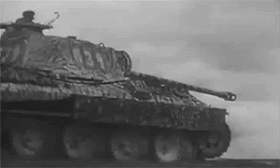 |
| Panthers of the 5. SS Panzer Division Wiking in action in the Kovel sector during the spring of 1944. |
 |
| Wiking Division Panther immobilized with track damage, but the gun is in working order, so the crew provides fire support. Kovel sector, spring 1944. |
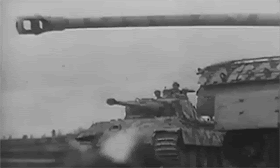 |
| Panthers of the 5. SS Panzer Division Wiking in action in the Kovel sector during the spring of 1944. |
Nobody took a Panther lightly on the battlefield, and one Panther was more than a match for a Sherman tank or three. The presence of a Panther right behind you blasting away, pounding the living hell out of the enemy trying to take your position, was about as reassuring a feeling as a Heer soldier could ever get in combat.
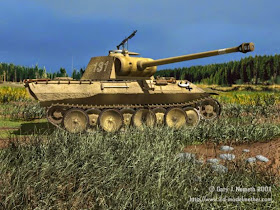 |
| Panzer V (colorized). |
Germany gets a lot of credit for its tanks, and with good reason. However, German panzers weren't always quite the world-beaters that their later reputation might suggest. Germany started World War II with tanks that were a cut above those of their immediate opponents such as Poland and France, true. However, as time went on, that advantage was eroded away.
 |
| A Waffen SS tank officer. He has a Tank Destroyer patch, which you wouldn't get as a tank commander - it was for destruction of a tank by an individual. So, either he transferred into the panzer arm, he somehow lost his mount at some point and destroyed a tank as an infantry soldier, or he's simply borrowing someone's uniform. |
The real secret to the Wehrmacht's tank force wasn't the tanks at all; it was the men inside them. German tankers received extensive training in tactics, and once on the battlefield, they received more experience on a continual basis than their opponents.
 |
| A somewhat more realistic Panther crew. These are the guys who you would be scared to face in real life, not the propaganda model above. |
With a continual need for tank interventions, German tankers often took their leave in the line. The German tank force was an amazing success due to tactical innovation more than tank quality. Many of the German tanks outclassed allied armor despite being basically comparable and in fact sometimes inferior, delivering far more casualties than they took in most engagements.
 |
| The side of a Panther tank turret, cracked by three glancing blows of 75 mm HE, June 1944. The three hits from 3rd/4th County Shermans killed the turret crew, but apart from cracking the thick armour plating did no other damage to the tank. And this was the Germans' "medium" tank. |
This was due to the impressive training the German soldiers received, and the excellent tactics used by the German forces. The key ingredient was the men inside the tanks and the tactics used to deploy them.
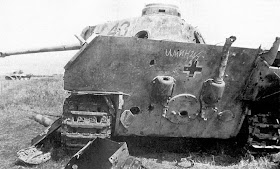 |
| Battle of Kursk, July 1943: A knocked out Panther tank lies in the battlefield of the biggest-ever clash of armored forces. The wreck has been most likely signed by the Russian who knocked it out to make certain that he got proper credit for the kill. |
Talent, though, could only take the German panzer forces so far. The Soviet Union, with all its military problems and inefficiencies, had so many resources that it could blunder about in some areas but still hit some home runs elsewhere. At Kursk, for instance, the Soviets had hundreds more tanks than the Wehrmacht.
 |
| A Panther in the field, covered with Zimmerit paste. |
The Germans only had a few dozen of their best tanks, the Tigers and Panthers, on each axis of the offensive. They were organized into discrete heavy tank units and not part of the general advance. There are pictures of trainloads of shining new Panthers being delivered to the front, but they are a bit deceiving. Tanks are only as effective as their crews, and the panzer men did not have sufficient men to learn their new mounts before the start of the Kursk offensive. In addition, many of the factory-fresh Panthers overheated (a very common problem), developed transmission problems (also common), or otherwise broke down - and their crews' unfamiliarity with their tanks' "moods" contributed to this problem.
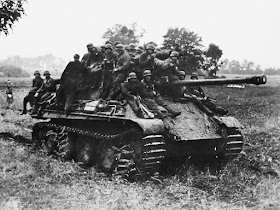 |
| Panthers were at their peak effectiveness in 1944. This picture shows why infantry loved to have a big tank handy. Looks like they have an entire late-war company on there. France, 1944. |
It was typical to have half or more of a unit's Panthers in the shop, unavailable for use. In reality, the Germans were still relying at Kursk upon pre-war Panzer IIIs, Panzer IVs and limited-traverse Stugs. These latter tanks were inferior to Soviet armor, but very cost-effective and reliable. Better to have an inferior tank for the infantry to rally around than no weapon at all.
 |
| Panther #800, Wiking division. |
With a constant and growing manpower advantage on all fronts after the first year of the war, the Soviet tankers could overwhelm the Germans. The initial talent gap also narrowed, and they were brave and increasingly capable themselves. The tank field was one area where the USSR made decisions early on that unexpectedly put it at a huge advantage in tank design over everyone else in the world, and that included Germany. From late 1941 onward, the Soviet tanks were at least comparable to German tanks, with any transient German advantage extremely tenuous.
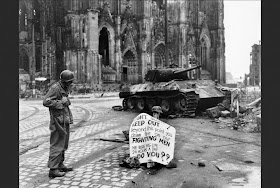 |
| The Panther destroyed at Cologne Cathedral, 6 March 1945. |
German Fuhrer Adolf Hitler had a very low opinion of Soviet military capabilities. His overall assessment was that "all we have to do is kick the front door in and the whole rotten edifice will come tumbling down." That was a catchy visual, but it was a bone-headed reason for starting a war against a country whose population was three times larger than yours. Just as important was that the Soviets could bury the Germans in the amount of coal and steel and oil and other raw materials they could dig up themselves or (especially after 11 December 1941) get from the Americans.
 |
| A Panther tank of I./Panzer-Regiment 27 of the 19. Panzer-Division at the intersection of ul. Powązkowska and ul. Elbląska. Parking at intersections was a favorite city defense tactic, because it offered clear lines of fire, but it also made the tank a huge target from several angles. Sometimes, they used two tanks at an intersection, but without extensive infantry support, it was a tactic doomed to failure. |
Hitler throughout his later life was stuck in the mindset of World War I, when Czarist Russia had no will to fight and steadily gave ground. People tend to forget that Germany completely defeated Russia in World War I. Since Russia ultimately threw in the towel during the revolution, this, in Hitler's view, proving the country's inherent inferiority. This was a not-unreasonable assessment based solely on those limited facts, shared by many abroad. The weakness turned out - most unfortunately for Hitler - to be highly specific to revolutionary Russia, when the country was highly distracted by internal problems and troops were unmotivated and poorly trained and supplied.
 |
| Panther of the 5th SS Panzer division “Viking” very carefully crossing a bridge. |
The successor state, the USSR, was brutal, highly efficient and ruthless, the complete opposite of Czarist Russia (well, except for the brutal part). Most significantly, unlike its predecessor, the USSR was supported by the Russian people, perhaps due to compulsion or sheer hope and not love, but supported nonetheless. When the Russian people are truly united, there is little that can stand in their way. This miscalculation ultimately cost Hitler his life.
 |
| 5th SS-Panzer-Division "Wiking" in Poland. Troops in a halftrack follow a German Panther tank into combat.... |
Germany had no tanks when Hitler took over in January 1933. In fact, Germany had a horrible history with tanks during World War I and thereafter, never coming remotely close to pinning down the right formula for armored warfare. Perhaps the least appreciated reason for the Central Powers' defeat in 1918 was the complete domination by England, France and the United States in tank warfare. The Germans were forced during that conflict to study Allied tanks and the tactics used in their implementation with an intensity reserved elsewhere only for catching serial killers or combating epidemics.
 |
| A Panther cruising across the steppe in 1943. |
Tactics were developed to defuse the tank threat, but Germany itself never managed to build any tanks worth squat. They basically tried to build fortresses on wheels, and they had almost no mobility and less firepower. German officers such as Heinz Guderian who were kept in the vastly reduced Wehrmacht after the war felt that tank inferiority deep in their souls and resolved during the inter-war years never to let it happen again. However, they could do nothing but study the problem under the terms of the Treaty of Versailles, which absolutely prohibited German tank production.
 |
| The 45 ton Panzer V “Panther” was now coming into service, intended to replace the Panzer IV as the main German medium tank. These were among the 200 Panthers being delivered to the Kursk forces. Several engines caught fire as they were coming off the train - Panther engines were in watertight compartments and were prone to over-heating, and the Ukraine in June/July is hot. When the Germans at the front saw this delivery, they must have thought they were golden in the coming offensive. June 1943. |
During the 1920s and early 1930s, the Germans worked with the Soviets in clandestine tank study at various secret bases in Russia. There were secret military bases near Voronezh where German officers could actually drive real tanks in violation of the treaty. This close pre-war cooperation, incidentally, is probably one reason Stalin was so blindsided by Operation Barbarossa.
 |
| 1.Zug / 6.Kompanie / SS-Panzer-Regiment 5 "Wiking" along with their main mounts, which were taken in the SS-Truppenübungsplatz Heidelager (located between Debica and Sandomierz in Poland), beginning of May 1944. These bad boys held Poland against the onrushing Soviet hordes until mid-January 1945. I think we can take a good guess which way is East. |
It was rumored that Hermann Goering spent so much time there at certain points that he acquired a Russian girlfriend. German designers kept updated designs for tanks during the period, though they could not actually see them built and thus had no real feedback.
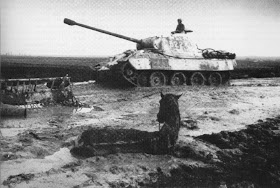 |
| Somewhere on the Eastern Front. |
In 1934, when Hitler effectively nullified the terms of the Treaty of Versailles by openly violating its terms, those plans were pulled out of the drawers and actual production began.
 |
| An American soldier inspects an abandoned Panther tank of the 2nd SS Panzer Division at Manhay in Belgium, December 1944. It may have run out of gas and with its last fuel been driven or pushed off the road to let other retreating Germans by. |
Starting from scratch, Germany started building light (Panzer 1 and Panzer II) and medium (Panzer III and Panzer IV) tanks. It was an ambitious building plan, and by the end of the 1930s all four models were available in sufficient quantities to overawe Germany's immediate neighbors. However, the designs were locked in place by 1934, with mass production of the most effective tank, the Panzer IV, beginning in 1936. The German industrial base was so weak that if Hitler wanted quantity, he had to begin mass production early. This gave him cutting edge quality in 1939, but as time wore on, other countries had the opportunity to leapfrog Germany's 1930s tanks. The only one that did so with any effectiveness was the Soviet Union, which had aggressive plans of its own.
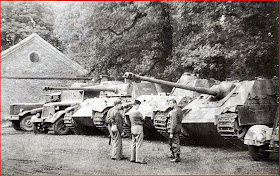 |
| Allies guard a seized German Zugkraftwagen and two Panther tanks. The one on the right is a Jagdpanther. |
After Germany had crushed all of its neighbors with the infamous "Blitzkrieg" (a term invented by British newspaper writers), its tanks were considered all-powerful. The combination of rapid tank thrusts and close air support - the essence of Blitzkrieg - proved unstoppable against countries that had neglected their own tank development. By late 1940, Hitler thus had outlandish views on his own military capabilities, and, due to his successes, nobody could with any credibility voice a contrary view. He had won the argument about his strategy - right at the point where it was going to show its vulnerability.
 |
| An intact captured Panther tank in Apulia, February 1943. Perhaps a drive failure, or simply ran out of fuel. |
After sweeping through Yugoslavia and Greece with his tanks in spring 1941, once again brushing aside feeble resistance to his growing tank arm, Hitler figured that nobody could stand up to him. He was not stupid, however, and realized that Germany's military dominance might be transient and that his own health was not perfect. Thus, without any pause he invaded the Soviet Union on June 22, 1941 in Operation Barbarossa. The German Generals were not nearly as enthusiastic about this campaign as Hitler was, but once again they were proven wrong: the German tanks raced into the endless expanse of the Soviet Union and soon stood at the gates of Moscow and Leningrad. The Soviet tanks, like their planes, were found to be obsolete and ineffective, leaving the Germans to worry more about mechanical breakdowns and supply to their far-ranging panzers than about tank opposition.
 |
| Panther Tank and crew. |
However, the Soviet Union was falling back upon defensible lines manned by fresh forces. The further the Germans advanced into the expanding geography of Russia, the more tenuous their own concentrated tank strength became. German tanks also had been designed for mild western European climates. Russian winters were something altogether different.
 |
| A Panther from the Wiking Division carrying infantrymen under fire, possibly from 5. Jäger-Division, during the defensive operations around Warsaw in August 1944. The soldier in the foreground is armed with a StG 44 assault rifle. Soldiers of all armies like to hitch rides on tanks. |
Soviet leader Josef Stalin (he changed official titles throughout the war but always was the dictator in charge of everything) did not like or, to be truthful, plan to give up so much ground, but it is better to be lucky than right. True panic did not descend upon Moscow until mid-October, when reports of German tank breakthroughs sent communist officials fleeing for safety in cities further east.
 |
| Three French boys looking at a knocked-out German Panther tank in the Falaise pocket, Normandy, 25 August 1944. Colorized. |
It was at this point, October 1941, that Stalin finally unleashed the trump card that he had been holding all along. His people secretly had been developing two tanks, the T-34 and the KV-1 (Kliment Voroshilov)), the former being a medium tank and the latter a true heavy tank. These were absolute secrets to the outside world, only shown off occasionally, once to visiting Americans well before the war (Stalin probably figured they would not understand their significance or tell the Germans about them, and he was right).
 |
| Some bridges were just not designed to handle 45-50 tons. |
Having hoarded his supply of them and built up production - they had only begun rolling off the assembly lines in 1940 - Stalin and his chief lieutenant General Georgy Zhukov finally unleashed the two new models (after only sporadic use during the early days of the war). They beset the Germans in in front of Riga in the north and Moscow in the center of the line.
 |
| Unloading Panthers in Russia sometime in 1944. |
The Germans were shaken. German accounts of the time are full of amazed and fearful reactions to the power of the "new" Soviet tanks. One T-34 reportedly crashed through an entire German regiment, blowing up everything in sight including tanks and antitank guns, before finally being stopped with an 88 mm antiaircraft gun at close range over open sights. Field Marshal Paul Ludwig Ewald von Kleist, a top German General, noted that the T-34 was "The finest tank in the world." That is quite an accolade coming from a Panzer General, but he was only speaking the truth.
 |
| Panther aka Panzer V. |
Guderian, trying to break though to Moscow via Tula in charge of Second Army, realized the danger at once. He was the top German tank theorist of the times, perhaps the most accomplished in the world, having set the original specifications for all the German tanks then in use and written the classic book on tank theories, "Achtung - Panzer!" He set up a commission (the "Panzerkommision") to examine the T-34. It reported back quickly that the entire Soviet design was superior to the best German tank, the Panzer IV, and that its superior attributes included shot-resistant sloping armor that was thicker than German armor and wider tracks, which gave the T-34 more grip on the muddy ground common in Russia. The tracks enabled it to move better than German tanks which had thinner tracks that were more suitable for paved roads and fields covered with vegetation. The T-34's main gun, at 76.2 mm, also was considered superior to the guns in the German tanks (which thus had to be upgraded).
 |
| U.S. Bazooka team destroys a Panther tank, Normandy 1944. While this looks quite heroic and probably is, there is a possibility - due to no Germany infantry in sight, the GI sitting out in the open looking as though he may be an instructor, the obliviousness of the German tank crew, the very fact that it is being photographed and so nicely framed - that this is simply a training assignment or propaganda shot using an already destroyed Panther. |
Brushing aside some very serious and demeaning suggestions that the German manufacturers should simply copy the T-34 outright, Guderian and Armaments Reichminister Todt tasked the major German manufacturers with coming up with a better design. Two specifications were published, one for a medium tank similar in size to the T-34, and one for a heavy tank like the KV.
 |
| The Panzer V 'Panther.' |
The latter project ultimately became the Tiger Tank, while the former turned into the Panther. In one of the most phenomenal military production feats of the war, Daimler-Benz (DB) and Maschinenfabrik Augsburg-Nürnberg AG (MAN) came up with designs within weeks and, after speedy review, the MAN design was chosen in May 1942.
 |
| A Panther on display. |
Hitler interfered, as usual, and demanded more armour and other modifications. Albert Speer in his autobiography 'Inside the Third Reich' noted:
Since the Tiger had originally been designed to weigh fifty tons but as a result of Hitler's demands had gone up to fifty seven tons, we decided to develop a new thirty ton tank whose very name, Panther, was to signify greater agility. Though light in weight, its motor was to be the same as the Tiger's, which meant it could develop superior speed. But in the course of a year Hitler once again insisted on clapping so much armor on it, as well as larger guns, that it ultimately reached forty eight tons, the original weight of the Tiger.
This 'medium' tank wound up heavier than the subsequent American M26 Pershing, which itself was considered a heavy tank and barely saw combat in Europe. In fact, the Panther wound up at the original weight of the Tiger, which had been planned from the start as a heavy tank. It took time to set up factories and machine tools, so the first Panther tanks did not roll off the assembly line until December 1942 - but that was barely a year after the Germans had first realized the need for a new tank. This was one of the areas where a command economy, which depended completely upon slave labor and mistreated common German and allied workers, could turn out a product faster than anywhere else, at a terrible cost in human suffering.
 |
| Panther Tank and crew. |
Originally, the Panther had been specified to have a weight of 35 metric tons. Hitler, though, interfered with the design as he was wont to do, and he demanded thicker armor and other modifications. This did not slow down the tank's production schedule very much, but it increased the weight of this supposedly medium tank to 45 tons - which new Armaments Reichminister Albert Speer acidly noted in his diary had been the original specified weight of the "heavy" tank.
 |
| This probably was taken at Kursk. |
The increased armor did prove useful in combat and it was a reasonable trade-off, but the additional armor and other features put increased strain on the drive train and other components related to mobility. The tank had a crew of five: driver, radio operator (who also fired the bow machine gun), gunner, loader, and commander. Frontal armor after the modifications was 80 mm, and the turret front plate was 100 mm (as a rule of thumb, it takes a gun of a similar caliber to penetrate armor of a certain thickness, so the Panther front armor would withstand a direct hit from just about any other tank in the world).
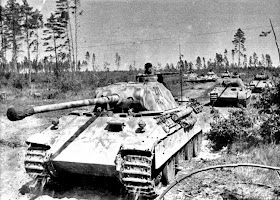 |
| German Panther tanks in column formation. |
The Panther was powered by Maybach V-12 gasoline engines, first 650 metric hp and later 690 hp. The main gun was a 7.5 cm Rheinmetall-Borsig KwK 42 (L/70) with semi-automatic shell ejection and a supply of 79 rounds (82 on Ausf. G), compared to the 8.8 cm gun in the Tiger. The Panther's gun did, despite being smaller than the Tiger's, have some advantages over the 88 mm, such as greater penetrating power and a flatter trajectory which made aiming easier due to the longer gun barrel. The weak link was the transmission assembly, or the "final drive," which was prone to breaking down due to the vehicle's massive weight.
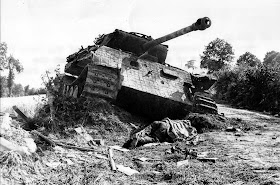 |
| A knocked out German Panther tank likely from the Panzer-Lehr Division in France. In the foreground a dead panzer-grenadier has had a shelter half-placed over his upper torso. It was on a road, probably an air attack. |
Compared to that, all other flaws in the Panther design - such a tendency for the armor to fracture under certain hits due to raw material shortages, and thin side armor - were insignificant. It was not at all uncommon for World War II tanks, especially early in their use, to suffer more mechanical breakdowns than destruction by the enemy, and the Panther followed that common pattern.
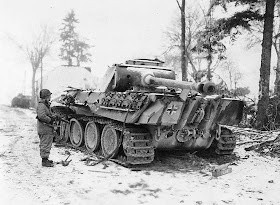 |
| A disabled Panther tank in the Ardennes. Note how slack the track at left is, and the road wheel damage. The American soldier is carrying an M1A1 Thompson submachine gun. It appears that the tank was retreating ("advancing to the rear") and firing behind when they broke down. There may be another panzer just up the road, too. |
Throughout its career, the Panther had to be babied by its driver (pivots were particularly stressful) or it risked a drive breakdown, and such breakdowns happened with regularity anyway no matter how skilled the driver. The French after the war did a study and found that most abandoned Panzers found along the road were there because of a broken drive.
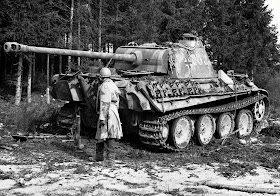 |
| An abandoned late model Panther Ausf. G with the ‘chin’ mantlet, belonging to the 1. SS Panzer Division Leibstandarte Adolf Hitler left in the woods of the Ardennes Forest. Perhaps abandoned for lack of fuel, December 1944. |
It took time to iron out the kinks in the Panther, but overall it was an outstanding design and its flaws were understood to be an acceptable and unavoidable consequences of Germany's general industrial situation. When it managed to get into battle, the Panther was a deadly weapon. It was rated so highly by Hitler that he delayed his Kursk offensive for weeks and weeks, waiting for the Panther to become ready in sufficient numbers to make a difference. This perversely contributed to the German defeat, for while the Panzer Divisions did get some Panthers, the delay also gave the Soviets time to pour defensive elements into the threatened zone. The Soviets won that mini-war of concentration of power, though it was a much closer outcome than many now think.
 |
| A lonely Panther in the snow. |
Kurk was the first and, ultimately, the most decisive battle in which Panthers operated. After months of frantic rebuilding of the first defective Panthers to come off the assembly line, the first delivery of Panthers finally arrived at 4 Panzer Army (Panther Regiment von Lauchert, of the XLVIII Panzer Corps ) in the last week of June 1943 (almost a full year after the first Tigers appeared in a combat zone). There were 200 in the initial shipment, and they had to be rushed into combat when the battle of Kursk began a week later, on July 5, 1943.
 |
| Battle of the Bulge, Air Liaison officers from 9th Air Force check out a knocked out German Panther tank knocked out by P-38 Lightnings in St.Vith, Belgium area. |
Many Panthers broke down before the battle and others broke down during the battle, but those that got into combat and did not malfunction were credited with the destruction of 267 Russian tanks. This was a good score, even a great one, but the Germans had to do way better than roughly break even - especially with such a cutting edge tool into which so many hopes and resources had been placed - in order to break the overwhelming Soviet advantage in material. The Germans had some 2500 tanks at Kursk, and the vast majority were the old warhorses Panzer III, Panzer IV and StuG IIIs and IVs. The Panthers were a nice addition and held their own, for sure, but they did not make a difference - beyond causing the delay that put the entire German position in a worse bind.
 |
| Captured German Pz. Kpfw. V Panther tank, Wyler, Germany, 9 February 1945. |
The Panthers were superior weapons when they could stand off and fire across open fields at medium or long range. They were at a huge disadvantage, however, under street-fighting conditions due to their long guns and thin side armor. The Panthers thus did better in the open fields of Russia than they did in the bocage country of Normandy, where they had difficulty turning and opponents could creep up on them unobserved and fire a bazooka into their sides. German doctrine thus had to emphasize infantry flank protection for the vulnerable Panthers. There were never at any point during the war more than 522 operational Panthers on the Eastern Front, which was not enough.
 |
| A Panther made to look like an American tank during Otto Skorzeny's Operation Greif. All of these spy tanks were quickly knocked out. |
That sounds like a lot, but the front was 2000 miles long. The number of Panthers was maintained in the hundreds to the very end of the war, but Germany needed more - many, many more. The Panthers were continually improved, some with incredibly advanced attributes such as night vision, and that helped slightly to compensate for the huge numerical disadvantages facing the Wehrmacht. Even the basic models, though, could take on any tank in the Allied inventory despite being considered only a "medium" tank.
 |
| Pzkpfw V Panther Ausf G Sperber FG 1250 Infrared Night Vision, the first with this equipment. |
Towards the end, the Panthers were hoarded and used in special situations, which shows both its perceived value to the Germans and its devastating scarcity. Overall, roughly 6000 came off the assembly lines from multiple manufacturers, and a large fraction were always back with the mechanics.
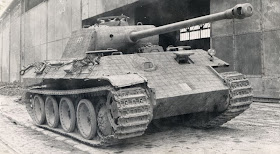 |
| A Panther of the French 503e regiment 1947. A few Panthers were used in the victors' armies for a few years until replaced by new models. |
There is huge consensus that the Panther was a better weapon than the Panzer IV. However, the best way to judge the Panther still is to compare it to that Panzer IV, which ostensibly it replaced - though it never really did. The Panzer IV was used throughout the war anyway, alongside the Panther after mid-1943. The Panzer IV was constantly upgraded, and always available in greater numbers than the Panther. The Panzer IV had a weaker gun which could barely handle the T-34 (even after upgrades) and the frame was much more vulnerable to counter-fire. It also was not as capable of handling the brutal Soviet climate. Plus, the Panther just looked more menacing.
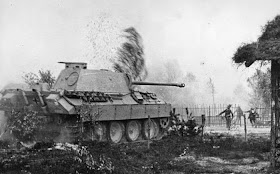 |
| Under the cover of supporting fire from a Panther tank, panzergrenadiers of the Großdeutschland division storm a Soviet held village. That dirt flying up into the air wasn't from the wind. |
However, the Panzer IV also was more reliable, more maneuverable in tight quarters, and they were there when you needed them. Their crews were better-trained and through experience understood the strengths and weaknesses of their mount better than the Panther crews did theirs. Many Panthers were lost by clueless crews who did not have the battle experience of the Panzer IV crews. The Panzer IV also was slightly cheaper than the Panther, though not by much (roughly 15% cheaper, though that figure is debatable based upon development costs and changing costs of the Panther as its development progressed).
 |
| Appears to be a captured Panther being taken for a spin. |
The Wehrmacht was extremely slow to recognize the value of the Panzer IV and extremely quick to try to replace it, but while later designs like the Panther were more deadly, the Panzer IV contributed more to the overall war effort.
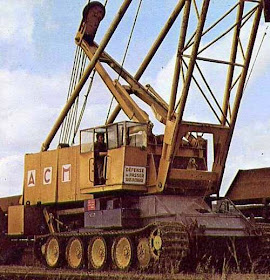 |
| A Panther being put to good use in Germany, 1960. |
The Panther was worth the trouble. It was a good tank and feared by its opponents. However, it was not the war-winning weapon that the Germans needed, and thus must ultimately be judged a failure.
 |
| US troops inspect destroyed German Panther V tank in Normandy area 1944. |
 |
| Two GI's examine a Panther, probably destroyed by air attack. |
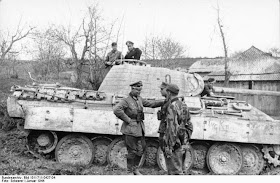 |
| Colonel Karl Lorenz, commander of an infantry regiment of German Army 'Großdeutschland' Division, talking to soldiers in the southern Eastern Front, mid-Jan 1944; note Panzer V Panther Ausf. A tank. |
 |
| Knocked out German panther tank, missing track on one side. "Ger. tank Volturno Valley."” From box originally labeled "Italy. Naples-Capri...." |
 |
| Italian Campaign, March 1944: under a pouring rain a column of 7,5 cm Sturmgeschütz 40 Ausf. G (Sd.Kfz. 142/1) and Panther tank of the 26th Panzer Division (Panther I./Pz-Reg 4) briefly parked on the borders of muddy lane of a rural area during the movement to Nettuno front. |
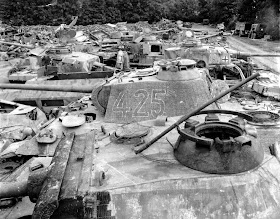 |
| Panther tanks captured by the Allies in Normandy France, summer 1944. Twilight of the Gods. |
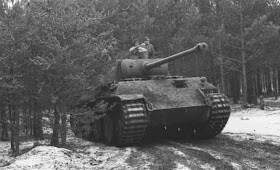 |
| Panther with commander out for blood. |
 |
| Overturned German Panther tank at Norrey-en-Bessin, 27 June 1944. The tank was up-ended during the Allied heavy bomber raid at the start of Operation 'Epsom'. This Panther belonged to Panzer Regiment 12 of the 12th SS-Hitlerjugend Division. |
 |
| Close in shot of Panther, gunner, driver, and commander up top. |
 |
| Sd.Kfz.171 Panther Ausf. A (130.Panzer-Lehr-Division). |
 |
| Germany's PzKpfw V, Panther, medium tank. |
 |
| Destroyed panther tank in Normandy. |
 |
| Night-fighting Panther Ausf.G equipped with an Infrared Night Vision Sperber (Sperber FG 1250) device (above the commander's cupola) on the testing site. It shows nice 'ambush' camouflage pattern (introduced August 1944), too. Obviously a tank being used for testing. |
 |
| Panthers in the field. The commander is probably going over tactics with other crew. |
 |
| Panther set up for an ambush in this propaganda photo. |
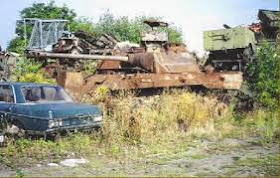 |
| A rusting Panther. From the car, this looks like it is circa 1960. If they kept it there for another 40 years, that rusting hulk would have been worth big money for the lucky owner. But, alas, few have survived in good condition. |
 |
| A GI visits a disabled German Jagdpanther (tank destroyer) built on a Panther chassis and deploying a 120mm gun, March 1945. Nice high resolution color shot. |
 |
| German defensive position in Berlin. consisting of a Panther a turret on a small bunker. |
 |
| Close up view of Panther crew being transported with their tank to France in June 1944. |
 |
| An abandoned Panther. No tread and it's probably been there for a while - but the gun probably still works. |
 |
| A famous photo of a trainload of German Panther Tanks detraining in the Eifel during October of 1944. |
 |
| A partially hidden Panther tank is visible here amongst all the soldiers. |
 |
| Commander on Panther tank (Federal Archive). |
 |
| A Panther at Kursk that broke down and had to be taken under tow. This was a common sight for Wehrmacht soldiers who worked around Panthers. |
 |
| PzKpfw V. 'Panther' Ausf. A early, Sd.Kfz. 171, I./Pz.Rgt. 4, Between Florence and Ravenna in Italy, March 1944. Tanks are nothing but giant slugs of metal without the men who fight in them, sweat in them, die in them. |
 |
| Another participant in Otto Skorzeny's Operation Greif: a German Panther Tank disguised to look like a M10 Wolverine tank destroyer, December 1944. |
 |
| A trainload of Panthers. Unless the person taking this was an official Wehrmacht photographer, which is doubtful, they were risking their life. If seen taking this photo, they could have been shot on the spot as a spy. As it was, British intelligence would have been interested in this photo, along with the date, location and time. |
 |
| Using that strand of trees as light camouflage, Panthers set up to take some long-range potshots at whoever is approaching. |
 |
| Panthers in action on the eastern front, 1944. |
 |
| Nice close-up of the glacis plate and turret, apparently from an exhibit. |
 |
| Elements of the 10th SS Panzer Division Frundsberg move to counter-attack British positions on Hill 112, southwest of Caen, in late June 1944. Every soldier who has ever gone into combat will recognize this scene - just don't fall off the front. They were successful that day, btw. |
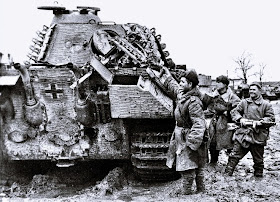 |
| March 13, 1944: Soviet troops celebrate the wrecking of a Panther. The tank received a direct hit in the rear, its most vulnerable spot other than the undercarriage. Otherwise, these monsters were immune to all tanks save direct hits from antiaircraft or field cannon. |
2019
















































































The Panther was one of the first, if not the first, Main Battle Tank, before the concept was devised (the British Centurion, being designated a "Heavy Cruiser" or "Universal" tank, was the first intentionally designed in the MBT role). It featured a judicious balance of firepower (probably a bit more on the tank-killing, especially at range, capability than against 'soft' targets), protection, and mobility. It'd have done even better if the Germans hadn't had to use a defective final drive unit which was the tank's Achilles Heel. Other issues included stuffing the Mayback HL210 (later HL230) engine into a relatively narrow, watertight compartment which promoted overheating, and, as the article points out, as the war wore on deficiencies in armor composition which resulted in excessive cracking and spalling for the protection desired.
ReplyDeleteOne MIGHT designate the original T-34s as also an ATTEMPT at an MBT, but the L-11 and later F-34 guns were too puny against more formidable enemy tanks. Certainly the T-34/85, slapped together in response to the Panther but correcting the original T-34 problems (inadequate gun, overworked commander), which debuted but a scant eight months after the Panther's rather poor one at Kursk, can likewise claim status as an MBT, at least in its heyday. Interesting, both set the basic design features which would characterize respective MBTs on each side, which for the Soviets, is not surprising as their ubiquitous T-54/55 and T-62 machines were outgrowths of the T-34, going more towards mobility and being 'squat', whereas American (Patton series), British (Centurion and Chieftain), and German (Leopard I) show the Panther's influence in favoring protection and firepower.
Interesting also that the French re-used not only the Panther itself but its KwK42 L70 gun in several post-war vehicles. Le Honeur pour la Patrie didn't get in the way of using what worked best.
Excellent article!
ReplyDeleteThe German tanks were not better in the early stages of the war, believe it or not the French had better tanks re: the Renault. The tactics were much superior, thanks to Guderian, read Auchtung Panzer. The allies especially the French were clueless on tank tactics , static , no idea on shoot and manoeuvre , not realizing that the motor was the most important part of the tank, gun, armour, motor! Speed was the essence according to Guderian. Tank formation as well with speed , this concept was critical to the formula of blitzkrieg.
ReplyDelete